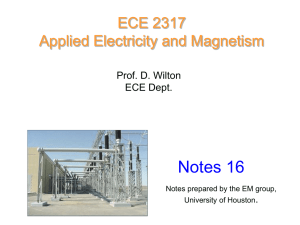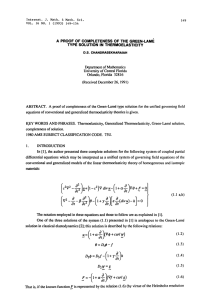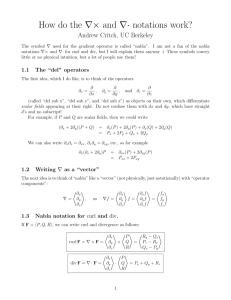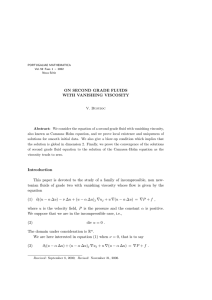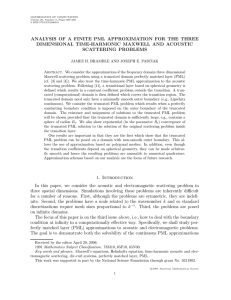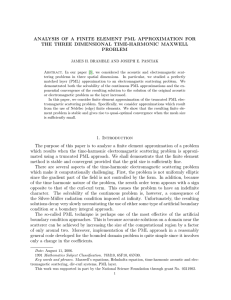Stokes` theorem.
advertisement
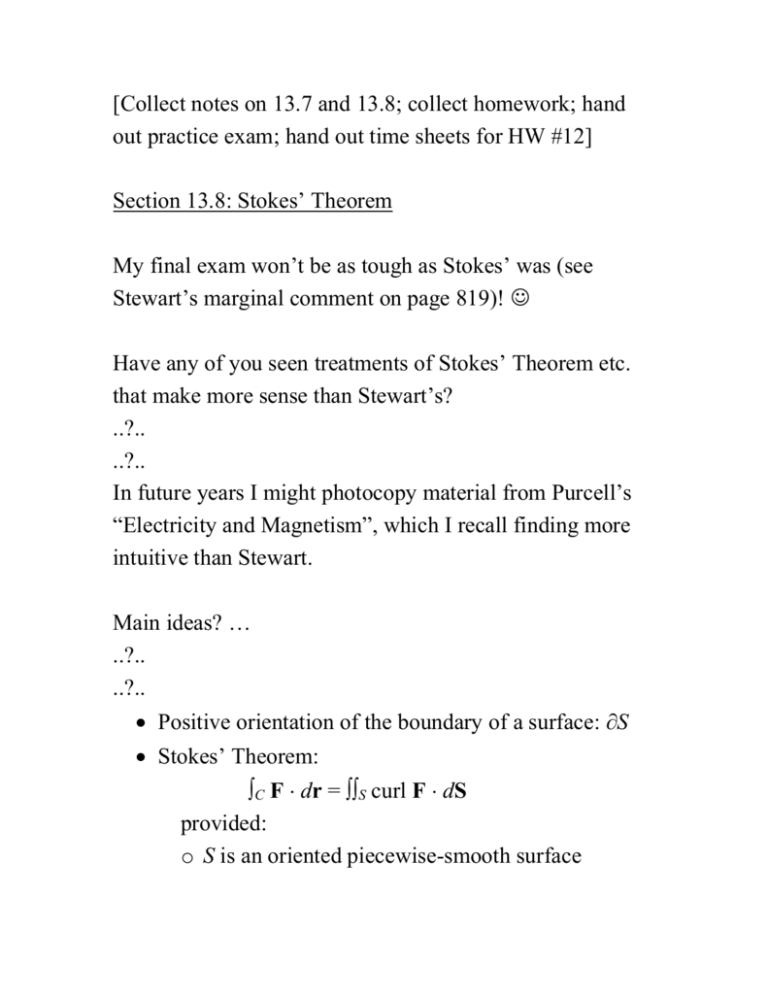
[Collect notes on 13.7 and 13.8; collect homework; hand out practice exam; hand out time sheets for HW #12] Section 13.8: Stokes’ Theorem My final exam won’t be as tough as Stokes’ was (see Stewart’s marginal comment on page 819)! Have any of you seen treatments of Stokes’ Theorem etc. that make more sense than Stewart’s? ..?.. ..?.. In future years I might photocopy material from Purcell’s “Electricity and Magnetism”, which I recall finding more intuitive than Stewart. Main ideas? … ..?.. ..?.. Positive orientation of the boundary of a surface: S Stokes’ Theorem: C F dr = S curl F dS provided: o S is an oriented piecewise-smooth surface o C (= S) is piecewise-smooth whose orientation is consistent with that of S o F is a vector field P,Q,R o P, Q, and R have continuous partial derivatives on an open region in R3 that contains S. Uses of Stokes’ Theorem: o Converting a line integral (around a closed curve) into a surface integral (see Example 1) o Converting a surface integral into a line integral (see Example 2) Relation between Green’s Theorem and Stokes’ Theorem: o GT is a special case of ST o GT is used in the proof of ST Analogy between Fundamental Theorem of Calculus, Fundamental Theorem of Line Integrals, and Stokes Curl and circulation: ((curl v)(P)) n = limr0 (C(r) v dr) / Area(D(r)) where C(r) = D(r), with D(r) the disk with center P, radius r, and unit normal vector n Stokes’ Theorem proves that a vector field F in R3 is conservative if and only if curl F = 0: in the “hard direction”, we have C F dr = S curl F dS = S 0 dS = 0 In his discussion of Example 1, Stewart says “Although there are many surfaces with boundary C, the most convenient choice is the elliptical region S in the plane y + z = 2 that is bounded by C.” But what if we use the surface S consisting of the sides and bottom of the partial cylinder shown in Figure 3? What is the contribution to S curl F dS coming from the sides of the partial cylinder? ..?.. ..?.. Recall that curl F = (1 + 2y) k. ..?.. ..?.. Since k is perpendicular to dS, we have k dS = 0, so there is no flux of curl F through the sides of S. What about the bottom of the partial cylinder? ..?.. ..?.. We get D (1 + 2y) dA (just as in Stewart’s approach), only now we didn’t need to us Equation 13.7.10; the unit disk isn’t being used to parametrize a surface --- it IS the surface! Is there a better way to compute D (1 + 2y) dA than Stewart’s? ..?.. ..?.. Look ahead at the answer (π), which gives a clue. ..?.. ..?.. Symmetry (specifically, odd symmetry with respect to y) tells us that D y dA = 0, so D (1 + 2y) dA = D 1 dA = Area(D) = π. Can we use symmetry arguments to get a simpler solution to Stewart’s Example 2? (The fact that the final answer is 0 should make us suspect that there is such a solution!) ..?.. ..?.. I wasn’t able to find such a solution, but maybe one of you can! Let F = xz i + yz j + xy k as in Example 2, and let S be the sphere of radius 1 centered at (1,2,3). Find S curl F dS. ..?.. ..?.. Surface integrals over closed surfaces: If S is a closed surface, (*) S curl F dS = 0. Proof #1: If S is a closed surface, its boundary is the empty set, so S curl F dS = S F dr = 0. Proof #2: Let C be a piecewise-smooth simple closed curve that divides S into two pieces S+ and S–, so that C is positively oriented with respect to S+ and negatively oriented with respect to S–. [Draw picture.] Then S curl F dS = S+ curl F dS + S– curl F dS = C F dr + –C F dr = C F dr – C F dr = 0. Hybrid proof: Draw a curve C, but let it shrink down to a point. Suppose we have to evaluate C F dr where C is the unit circle in the x,y plane, and we suspect that Stokes’ Theorem would be helpful. What are some surfaces S for which S = C? ..?.. ..?.. The unit disk in the x,y plane; the hemisphere x2+y2+z2=1, z0; the half-ellipsoid x2+y2+z2/4=1, z0; the paraboloid z=x2+y2–1, z0; etc.




